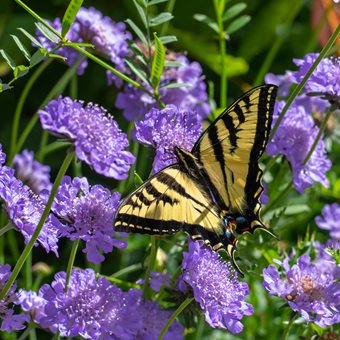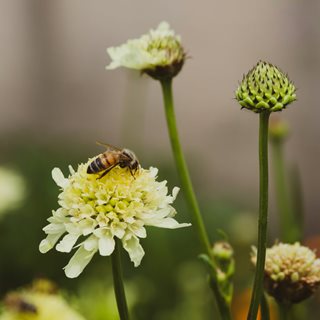Scabiosa: How to Grow Pretty Pincushion Flower
Get planting and care tips for this prolific, fuss-free bloomer.
Pincushion flower with Western Tiger Swallowtail butterfly. Photo by: Jennifer Bosvert / Shutterstock
It’s amazing that a flower as lovely and long-blooming as Scabiosa isn’t a staple in every garden. Better known as pincushion flower, this easy-care plant is a top performer from late spring into fall, putting on a continuous display of frilly dome-shaped flowers. In mild winter climates, some pincushion flowers will even bloom all year long!
Far too pretty to be confined to garden beds and borders, pincushion flower also makes a charming addition to container plantings, either alone or in mixed arrangements. And if you love freshly cut flowers, the seemingly endless supply of blooms will give you plenty of extra to keep your vases overflowing.
On this page: Basics | Planting | Care | Varieties | Frequently Asked Questions
BASICS
Botanical name:
Scabiosa spp. and hybrids.
Common name:
Scabious, pincushion flower, sweet scabious
Plant type:
Genus includes both perennial and annual species
Zones:
Typically 5-9, for perennial types
Exposure:
Full sun
Mature size:
12 to 36 inches tall and 10 to 24 inches wide, depending on the variety.
Habit:
Clump-forming habit
Bloom time:
Late spring until frost
Foliage:
Oblong, pinnately lobed leaves may be blue-green to gray-green. Foliage of perennial varieties remains evergreen in mild climates.
Flowers:
Blooms borne on tall, wiry stems come in shades of pink, purple, white, blue, yellow, and burgundy. Each flower features an outer ring of frilly petals surrounding a domed pincushion-like center with protruding stamens that resemble tiny pinheads.
Special attributes:
- Attracts butterflies, bees, and hummingbirds
- Deer and rabbit resistant
- Drought tolerant
- Excellent for cutting
Landscape uses:
Borders, mass plantings, container gardens, cottage gardens, cut flower gardens, pollinator gardens, and meadow gardens.
PLANTING SCABIOSA
When to plant:
In early spring, after the last frost date. In areas with mild winters, you can also plant Scabiosa seeds in late fall for flowers the following season.
Where to plant:
Pincushion flowers will bloom best in a site that receives full sun (at least 6 hours of direct sunlight daily), but will appreciate some afternoon shade during the heat of the summer. Because they prefer cool conditions, plants may struggle if grown in an extremely hot, humid climate.
How to plant:
You can plant pincushion flowers from nursery transplants or seeds. If you choose to grow them from seed, start them indoors under grow lights 4 to 6 weeks before the average last frost date in your area or sow them directly in the garden after all danger of frost has passed. Cover the seeds with a thin layer of soil (about 1/4 inch deep) and keep them evenly moist but not waterlogged until the seeds germinate.
In the garden, space transplants or thin seedlings to a spacing of at least 12 inches apart to allow for good air circulation.
Soil:
Prefers well-drained, loamy soil rich in organic matter. Good soil drainage is essential, since root rot may occur in overly wet soil. Scabiosa plants are particularly intolerant of wet soil during winter and tend to be short-lived.
SCABIOSA CARE
Watering:
Keep your pincushion flowers well watered during the first year after planting, giving them at least an inch of water a week. Older, established plants are more drought tolerant, but will still appreciate regular watering during prolonged dry spells. To prevent root rot, make sure the soil is well drained and don’t allow it to become soggy. Pincushion flowers don't like getting wet feet.
Amendments and fertilizer:
Because Scabiosa grows best in fertile, well-draining soil, amend it at planting time with compost to improve drainage and add nutrients, especially if you have heavy clay soil. Also apply a layer of mulch around the root zone of your plants to help keep the soil moist and insulate the roots from temperature extremes.
Although pincushion flowers are light feeders, a bimonthly application of a balanced fertilizer for flowering plants will help keep them blooming throughout the season.
Pruning and deadheading:
To promote new blooms and keep your Scabiosa looking fresh, remove the spent flowers by clipping the stems down to the basal foliage (the leaves that grow from the base of the plant). Pruning is generally not required, unless you want to encourage fuller growth or remove dead or damaged foliage.
Harvesting flowers:
For the longest vase life (a week to 10 days), harvest your pincushion flowers when they are still in the bud stage or just beginning to open. If you’re harvesting the seedheads for dried floral arrangements, cut the seedheads while still fresh and then hang them to dry.
Propagating:
Can be propagated by seed or division. Divide perennial types every 3 to 4 years or whenever they become crowded and bloom production dwindles. The best time to divide plants is in early spring. (*See note below on propagating or dividing patented plants. Check your plant tags for the ® or ™ symbol by the plant name.)
Winter care:
For perennial varieties, cut the stems back to the bottom leaves in the fall and protect plants with a light layer of mulch, such as shredded leaves, hay, or evergreen boughs. Do not cut back into the basal foliage, which will remain evergreen to semi-evergreen for most of the winter. In early spring, before new growth begins, you can remove any dead outer leaves.
Pests and diseases:
Generally pest-resistant and disease-free, although they may succumb to powdery mildew during periods of high humidity. To help prevent fungal diseases, avoid overhead watering and provide adequate spacing between plants.
SCABIOSA VARIETIES
FREQUENTLY ASKED QUESTIONS
Is Scabiosa a perennial or annual?
Scabiosa species include both perennial and annual types. While perennial varieties (such as S. caucasica and S. columbaria) will come back year after year, annual pincushion flowers (S. atropurpurea) will need to be replanted each year. However, they may re-seed under optimal conditions.
Does Scabiosa bloom all summer?
Yes! That’s one of the best attributes of pincushion flower. During the heat of midsummer, the blooms may taper off a bit, but they will return in abundance in early fall when cooler weather arrives.
Is Scabiosa hard to grow?
No. As long as you give your pincushion flower enough sun, plant it in well-drained soil, and water when needed, this fuss-free plant will thrive with very little effort.
Can I grow Scabiosa in a hot climate?
Generally, pincushion flowers dislike sweltering heat and humidity and prefer the cooler temperatures of early summer and fall. If you are growing your plants in an area with particularly hot summers, they will fare better when given some afternoon shade. For the best success, avoid growing pincushion flowers in a climate outside of its recommended USDA hardiness zones.
Should I deadhead pincushion flower?
Diligent deadheading will prolong the bloom period, but sometimes it can be hard to keep up, since an established plant can produce hundreds of flowers in a season. Don’t worry. The seedheads are quite attractive and can be left in place for ornamental interest or used in dried flower arrangements.
Does Scabiosa spread?
Some pincushion flowers can reseed in the garden, but are not considered to be invasive. If reseeding is a concern, plant a sterile variety, such as ‘Butterfly Blue’.
Does pincushion flower require staking?
Taller varieties have long stalks that tend to flop when laden with blooms, particularly when grown in overly rich soils. Staking plants or locating them near sturdier plants that can provide some support will help keep your pincushion flowers upright.
*REGARDING PROPAGATION: When it comes to propagating patented plants, there are strict rules in place prohibiting reproduction or propagation of these plants in any way. This means you can't reproduce them (even for use in your own garden), sell them, or bring them into the country without permission. The law does not make exceptions for what some might consider minor infringements. Any unauthorized use of patented plants is considered an infringement.

















